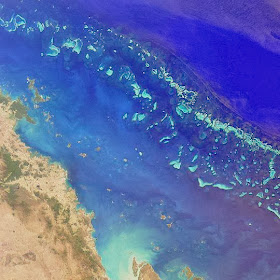 |
| Satellite image of part of the Great Barrier Reef adjacent to the Queensland coastal areas of Airlie Beach and Mackay [Credit: NASA] |
As the first comprehensive study of its kind on the deep-water fossil reef system in the Great Barrier Reef, the results are an analysis of the environments and time-frame the reefs developed in. These deep-water reefs are called mesophotic reefs and extend from 30 meters to 100 meters underwater.
The scientists collaborated with colleagues from the Australian Nuclear Science and Technology Organisation, Universidad de Granada, University of Oxford, University of Edinburgh, Aix-Marseille Université, Queen's University and the University of California.
The team are the first in the world to document and analyze the response of a mesophotic reef community to environmental disturbances over thousands of years, and to see how the reef responds to global sea-level rise and environmental changes.
"Nothing was previously known about the long-term record of mesophotic reefs on the Great Barrier Reef, and in fact, mesophotic reefs have been rarely, if ever, analysed using their fossil records, so this study is a real first," said Dr Webster.
"Significantly, our findings suggest that while these mesophotic reef systems have been an important part of the Great Barrier Reef's geologic past over the last 20000 years, they have actually been very sensitive to past environmental changes, such as sea level rises and increased sediment flux. This, of course, has relevance to how the modern Great Barrier Reef deep-water reef systems might behave in the future."
Dr Webster, together with his recently finished PhD student Liz Abbey looked at the mesophotic fossils. These are too deep to access via scuba-diving, so very little research has been carried out on this type of reef around the world, especially in comparison with their more accessible shallow water counterparts.
"Even in low light, the modern mesophotic reefs support corals, sponges and algae as the dominant structural components," said Dr Webster.
"We focused on three fossil mesophotic reefs in the Great Barrier Reef and examined the timing of their development, analyzed the species and uncovered the historical environmental settings for the reefs."
Using radiometric dating - carbon-14 and uranium-thorium dating - as well as analyzing the sedimentary layers and paleoecology of the fossil reefs, the team discovered that the mesophotic reefs in the Great Barrier Reef had two specific periods of growth.
"We found that there were two distinct generations of fossil mesophotic coral community in the Great Barrier Reef - the first period was from 13000 until 10200 years ago, with a roughly two thousand year break, then the second period from 7800 years ago until now," said Dr Webster.
"This period of over two thousand years when mesophotic coral growth was interrupted happened when there was a massive sediment flux, with sediment moving from the reef shelf to the basin. It appears that this huge movement of sediment happened as sea levels rose - flooding a huge area of the shelf during this time."
"It's very important to see how the mesophotic reef has responded to these challenges in the past, as we may be facing some of the same environmental changes in the near future, especially with global sea levels rising."

No comments:
Post a Comment